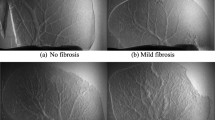Abstract
The application of digital holography in cell imaging is gaining attraction as it gives quantitative information related to optical thickness without the need for staining. In contrast, conventional pathology examination uses tissues or cells that are stained to visualize the morphological structure or molecular expression with color. However, the relationship between color information and quantitative phase inside histopathology specimen is not yet well understood. In this study, we developed a system to capture both a color image and digital hologram, and those of H&E (hematoxylin and eosin)-stained liver tissue were acquired. Then, we calculated and analyzed the relationship between the textural features inside the color and phase images for hepatocellular carcinoma (HCC) histopathological specimen. Upon experimental investigation, we found that gray-level co-occurrence matrix (GLCM) textural features in phase images are useful for discriminating cancer and normal tissue, and varies between HCC grades which bring the possibility to be utilized for HCC diagnosis or classification without staining procedure.







Similar content being viewed by others
Explore related subjects
Discover the latest articles and news from researchers in related subjects, suggested using machine learning.References
Al-Janabi S, Huisman A, Van Diest PJ (2012) Digital pathology: current status and future perspectives. Histopathology 61:1–9
Pantanowitz L (2010) Digital images and the future of digital pathology. J Pathol Inf 1:15
Kiyuna T, Saito A, Kerr E et al (2008) Characterization of chromatin texture by contour complexity for cancer cell classification. In: 8th IEEE International conference on bioinformatics and bioengineering, Athens, Greece, Oct 8–10, 2008
Kiyuna T, Saito A, Marugame A et al (2013), Automatic classification of hepatocellular carcinoma images based on nuclear and structural features. In: Proc. SPIE 8676, medical imaging 2013: digital pathology, p 86760Y
Mo X, Kemper B, Langehanenberg P et al (2009) Application of color digital holographic microscopy for analysis of stained tissue sections. In: Proc. SPIE 7367, advanced microscopy techniques, p 736718
Benzerdjeb N, Garbar C, Camparo P et al (2016) Digital holographic microscopy as screening tool for cervical cancer preliminary study. Cancer Cytopathol 124:573–580
Pham HV, Pantanowitz L, Liu Y (2016) Quantitative phase imaging to improve the diagnostic accuracy of urine cytology. Cancer Cytopathol 124:641–650
Takeda M, Ina H, Kobayashi S (1982) Fourier-transform method of fringe-pattern analysis for computer-based topography and interferometry. J Opt Soc Am 72:156–160
Herráez MA, Burton DR, Lalor MJ et al (2002) Fast two-dimensional phase-unwrapping algorithm based on sorting by reliability following a noncontinuous path. Appl Opt 41:7437–7444
Wienert S, Heim D, Saeger K et al (2012) Detection and segmentation of cell nuclei in virtual microscopy images: a minimum-model approach. Sci Rep 2:503
Haralick RM, Shanmugam K, Dinstein I (1973) Textural features for image classification. IEEE Trans Syst Man Cybern 3:6
Author information
Authors and Affiliations
Corresponding author
About this article
Cite this article
Norazman, S.H.B., Nakamura, T., Kimura, F. et al. Analysis of quantitative phase obtained by digital holography on H&E-stained pathological samples. Artif Life Robotics 24, 38–43 (2019). https://doi.org/10.1007/s10015-018-0468-4
Received:
Accepted:
Published:
Issue Date:
DOI: https://doi.org/10.1007/s10015-018-0468-4




